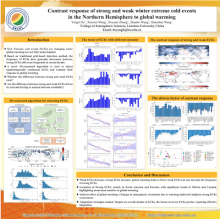Contrast responses of strong and weak winter extreme cold events in the Northern Hemisphere to global warming
Yongli
He
Lanzhou University
Poster
Changes in extreme cold events (ECEs) attract much attention due to their catastrophic effects on the economy and human life. Although evidence suggests that the frequency, intensity, and duration of ECEs have decreased significantly under global warming, a series of strong ECEs complicates their response to global warming. In this study, a 3D-connected algorithm was first used to detect spatiotemporally continuous ECEs in winter across the Northern Hemisphere (NH) and to evaluate the response of ECEs with varied intensities. Strong and weak ECEs are separated, and they show a distinct response to global warming. Weak ECEs significantly decrease in frequency, projection area and total area over the NH. However, the frequency, projection area and total area of strong ECEs show no significant trend, whereas they are increasing in Siberia and Canada. ECEs are influenced by global warming through both direct effects (increasing surface temperature) and indirect effects (changing atmospheric circulation). Based on the 1pctCO2 experiment from 22 CMIP6 models, the role of indirect effects in the contrast responses of strong and weak ECEs were investigated by removing the direct effect. The results indicate that the indirect effect is responsible for the contrast responses of strong and weak ECEs. The response of strong winter ECEs indicate that the risk of severe disasters remain, which motivates additional research to better prevent economic losses and develop adaptative strategies.

Poster file
He-Yongli-blocking-poster.pdf
(3.22 MB)
Meeting homepage
